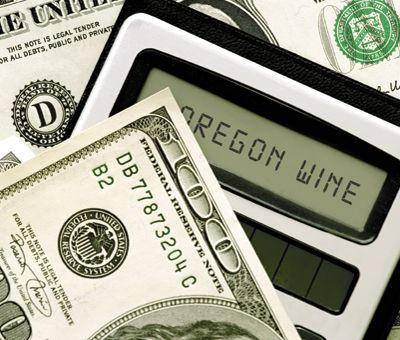Economic Impact Update

By Wine Press Staff
Despite weathering some of the toughest economic headwinds in recent memory, the Oregon wine industry has proved that it’s not merely resilient, but enjoying incredible momentum.
The industry is flexing its economic muscle to the tune of $2.7 billion, according to a new study commissioned by the Oregon Wine Board, a semi-independent state agency that manages industry marketing, education and research functions. The study, produced by Full Glass Research of Berkeley, Calif., shows that the Oregon wine industry’s economic impact on the state economy nearly doubled since the last study was conducted in 2005, when the impact was calculated at $1.4 billion.
That’s a 93 percent jump, and it included a stretch of time when the U.S. economy was performing at its lowest levels in the 50-year history of the Oregon wine industry.
“This study reflects the amazing performance by what is rapidly becoming the state’s leading agricultural industry,” said Sam Tannahill, chairman of the OWB. “Oregon wine is really on a roll, and we are poised to continue the kind of growth we have enjoyed recently as demand for our wines expands both nationally and internationally.”
The report is filled with positive news for Oregon’s 419 wineries and 849 vineyard owners, who completed an impressive decade of growth as the study so aptly validates. And the outlook for the future, while always uncertain, appears to be as bright as ever.
The popularity of Oregon’s high quality, artisan-style wines appears to be gaining momentum among savvy wine consumers. According to the study, their preference for Oregon wines climbed from 19 percent, five years ago, to 23 percent today.
Among those who had purchased Oregon wines in the previous three months, consensus that the wines were unique increased from 48 to 65 percent. Those who considered Oregon wines of superior quality compared to other wines increased from 42 to 59 percent since the last study was done in 2005.
“We’ve made some amazing strides over the past five years,” Tannahill said. “Oregon could not be better positioned to capitalize on the growing interest in the kinds of artisan, quality wines that are being produced by our wineries. This study demonstrates why it’s a very exciting time for Oregon wine.”
Tannahill said the study underscores the value that the industry brings to the state’s economy and shows the impact that it’s having on related industries such as tourism. He said the recently passed land-use legislation affecting certain commercial activities wineries are permitted to conduct is an important factor in helping wineries continue the momentum identified in the study.
“The passage of HB 3280 by both the House and the Senate really gives us a pathway to increasing and continuing that impact in a very clear way,” Tannahill said. “Granted, there are some mandates (in the legislation) that we need to continue to look at and work to clarify, but passage of HB 3280 will help us support the tremendous numbers that I’m seeing (in the study).”
Tannahill called the study’s results “a very pleasant surprise.” He noted that one of those surprises was Oregon’s percentage growth compared to other leading wine regions. When compared to its two larger wine-producing neighbors, Oregon has shown dramatically faster growth over the past five years. While California’s winegrape production grew by 17 percent and Washington’s by 21, Oregon’s production was up 38.
Tannahill said that establishing the uniqueness of Oregon wine has been an important factor. “We’ve done a good job of establishing that Oregon wines can only come from Oregon,” he said. “You won’t get the same thing from anyplace else in the world. We’re going to be successful across the board because we’re making some really special wine in all regions of the state.”
The study also offered insights into wine’s growing contribution to the state’s $8.7 billion tourism economy. While still small in percentage terms, wine tourism tends to be a larger contributor because it attracts upscale travelers who spend more money while in the state and often continue to consume Oregon products when they return to their homes.
“Wine is a significant destination driver,” said Todd Davidson, CEO of the Oregon Tourism Commission. “According to our research, a visitor’s experience carries an afterglow when they leave the state. We found that 43 percent of Oregon visitors said they are more or much more likely to purchase Oregon products than before their trip to Oregon.”
Oregon also enjoys an enviable position compared to other leading wine regions in the U.S. The state’s winegrowers maintain the highest average price per ton of grapes and the highest average revenues per case of finished product among leading domestic wine regions.
“I was surprised by how strong the growth has been and by how well the Oregon industry is rebounding from the recession,” said Christian Miller, the study’s author. “This recession was designed to impact the Oregon wine industry.”
He said while Oregon wine was affected more severely when the economy turned sour in 2008, it also saw a much sharper uptick than most other leading wine regions.
Another key to Oregon’s success has been the strides it has made in distribution outside of Oregon as well as direct-to-consumer sales through tasting room and wine club sales. Shipments of Oregon wine into out-of-state distribution increased 94 percent and direct-to-consumer sales — including tourists and out-of-state residents — increased 133 percent since 2005.
When asked about the future, Tannahill said the fact that he did not have a crystal ball did not dampen his optimism. “I’ve been in the Oregon wine industry for a good amount of time and the outlook is positive. We’re going to continue to be challenged, but Oregonians, in general, are a really creative, industrious, passionate group of people. This is a really an exciting time.”










